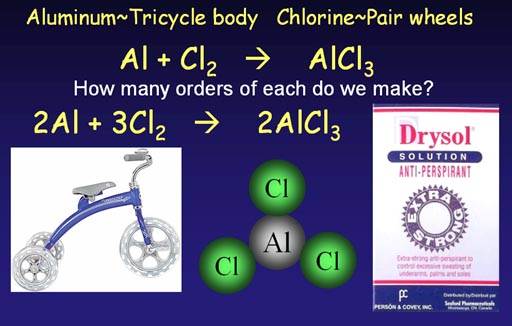

The equation is now balanced because there is an equal amount of substances on the left and the right hand side of the equation. To fix this unbalanced equation a 5 in front of the O 2 on the left hand side is added to make 10 O's on both sides resulting in P 4 + 5O 2 = 2P 2O 5 The left hand side has 2 O's and the right hand side has 10 O's. The left hand side has 4 P's and the right hand side has 4 P's. This equation is not balanced because there is an unequal amount of O's on both sides of the equation. This equation is a balanced equation because there is an equal number of atoms of each element on the left and right hand sides of the equation. The equation will now look like this: 4Na + O 2 = 2Na 2O To fix this 2 more Na's are added on the left side. Again, this is a problem, there must be an equal amount of each chemical on both sides.

The right hand side has 4 Na's total and 2 O's. Currently the left hand side of the equation has 2 Na atoms and 2 O atoms. Notice that the 2 on the right hand side is "distributed" to both the Na 2 and the O. Now the equation reads: 2Na + O 2 = 2Na 2O To fix this a 2 is added in front of the Na 2O on the right hand side. On the left hand side there are 2 O atoms and the right hand side only has one. In the next step the oxygen atoms are balanced as well. In this there are 2 Na atoms on the left and 2 Na atoms on the right. This problem is solved by putting a 2 in front of the Na on the left hand side: 2Na + O 2 = Na 2O As it stands now, there is 1 Na on the left but 2 Na's on the right. In order for this equation to be balanced, there must be an equal amount of Na on the left hand side as on the right hand side. Hydrogen and oxygen are usually balanced last. Generally, it is best to balance the most complicated molecule first.
#Chemical equation maker structures trial
Simple chemical equations can be balanced by inspection, that is, by trial and error. Using Trial and Error/Inspection Example #1 (Simple) By changing the scalar number for each molecular formula, the equation may be balanced.

In case of net ionic reactions, the same charge must be present on both sides of the unbalanced equation. Thus, each side of the equation must represent the same quantity of any particular element.
#Chemical equation maker structures how to
How to type chemical equation and arrows in Word 2007 and above.įor older versions of MS Word, go to the insert menu and click on the equation, which launches the Equation Editor Program (you can also find this program on your computer by searching for eqnedt.exe), which gives you the same ability to create equations.In a chemical reaction, the quantity of each element does not change. If you need to type above or below arrow just type "\above(text above arrow goes here)".Similarly tying below arrow just type \below(test below goes here)". For up arrow and down arrow showing gas liberation and precipitation use \uparrow or \downarrow followed by space Shortcut for typing arrows of chemical equation in Word 2007 and above.Ĭlick on the word "yields" and replace it with as many spaces as you need to create an arrow of whatever length you want. To get a long arrow, click on the operator but and choose the arrow with the word "yields" written over it under common operator structures. This feature on Word will also accept some (but not all) tex commands for formatting equations. You have access to a wide range of arrows from a pull-down menu, but -> will give you a simple right arrow (although it is not very long). For example, underscore _ creates a subscript and a caret ^ creates a superscript Shortcut for typing subscript and superscript in MS Word 2007|2010|2013|2016 and office 365. There are also shortcut commands to render most the common things you want. The default is to have letters italicized (as variables), so you will want to fix that. Alternatively you can use _ for subscript and ^ for superscript. Use the buttons in the ribbon to do superscripts and subscripts. (For shortcut you can press Alt+= sight together)Ĭlick on the equation button on the far right. It is designed for math but works okay for chemistry. If you are using MS Word 2007 or newer, use the equation feature.


 0 kommentar(er)
0 kommentar(er)
